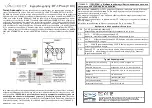
7 OSCillaTiOn CiRCuiT anD ClOCK COnTROl
7-6
Seiko epson Corporation
S1C63003/004/008/016 TeChniCal Manual
(Rev. 1.1)
Precautions
7.7
• When high speed CPU operations are not necessary, you should operate the peripheral circuits with the setting
shown below.
- CPU operating clock:
OSC1
- OSC3 oscillation circuit: Off (When the OSC3 clock is not necessary for peripheral circuits.)
- Clock manager:
Disable the clock supply to unnecessary peripheral circuits.
• Since several tens of µsec to several tens of msec are necessary for the oscillation to stabilize after turning the OSC3
oscillation circuit on. Consequently, you should switch the CPU operating clock (OSC1
→
OSC3) after allowing
for a sufficient waiting time once the OSC3 oscillation goes on. The oscillation start time will vary somewhat de-
pending on the resonator and externally attached parts. Refer to the oscillation start time example indicated in the
"Electrical Characteristics" chapter.
• When switching the clock from OSC3 to OSC1, be sure to switch OSC3 oscillation off with separate instructions.
Using a single instruction to process simultaneously can cause a malfunction of the CPU.
• Both the OSC1 and OSC3 oscillation circuits stop oscillating when the CPU enters SLEEP mode. To prevent the
CPU from a malfunction when it resumes operating from SLEEP mode, switch the CPU clock to OSC1 before
placing the CPU into SLEEP mode.
















































